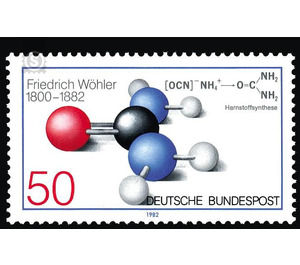100th anniversary of death Friedrich Wöhler - Germany / Federal Republic of Germany 1982 - 50 Pfennig
Theme: Calender
| Country | Germany / Federal Republic of Germany |
| Issue Date | 1982 |
| Face Value | 50.00 |
| Color | multi-colored white |
| Perforation | K 14:14 1/4 |
| Printing Type | 4-color rotogravure |
| Stamp Type | Postage stamp |
| Item Type | Stamp |
| Chronological Issue Number | 1021 |
| Chronological Chapter | GER-BRD |
| SID | 568554 |
| In 51 Wishlists | |
Friedrich Wöhler is today one of the best-known chemists. His scientific achievements as a researcher and teacher fall into a period of tremendous development and expansion of the subject of chemistry, which he has helped shape with his admirable creative power. Wöhler was born on 31 July 1800 in Eschersheim near Frankfurt, attended high school in Frankfurt and studied medicine in Marburg and mainly in Heidelberg, where he received his doctorate in 1823 to the doctor of medicine. Even during high school years, Wöhler had conducted serious chemical experiments and acquired special knowledge in mineralogy. Chemistry was not a separate subject at the universities at this time, it was taught within the medical study program. A study visit from 1823-1824 to the famous Swedish chemist Jakob Berzelius in Stockholm was of great importance to Wöhler, where he got to know the state of chemistry of his time. In 1824 Wöhler was a chemistry teacher at the municipal vocational school in Berlin. In 1828 he was appointed professor and from 1832 teaches at the newly founded higher vocational school in Kassel. In 1836 he follows a call to the Chair of Chemistry of the University of Göttingen. Wöhler works at the chemical institute of this university until his retirement in 1880. He dies at the age of 82 on September 23, 1882. Friedrich Wöhler's achievements in the field of chemistry are characterized by a wealth of experimental work covering the entire breadth of the subject. It can be divided into investigations in inorganic chemistry, chemistry of rock science, analytical chemistry, physiological and physical chemistry. Particularly outstanding is the representation of the aluminum after preparatory work Hans Christian Oerstedts and the description of the chemical characteristics of this element 1827 and in the following years. 1828 was the "artificial" representation of urea - one of the first examples of the phenomenon of isomerism. In the same year he isolates the elements beryllium and yttrium for the first time. In connection with the uric acid work, which was carried out together with the friend Giessen chemistry professor Justus Liebig, the authors were able to conclude in 1838: "The philosophy of chemistry will conclude from this work that the production of all organic matter, as far as it no longer Not only probable in our laboratories, but must be regarded as certain. " Of fundamental importance to the theory of science were also the "investigations on the radical of benzoic acid," by which Wöhler and Liebig were able to show for the first time that in organic chemistry larger groups of elements could undergo different reactions without decomposition. A later Wöhler achievement was the first presentation of calcium carbide and the resulting extraction of acetylene, a discovery that was applied decades later on an industrial scale. These are just a few examples from the work of Friedrich Wöhler. What remains unknown are the many mineral analyzes, the improvements of the representations of already known compounds, the improvement of analytical procedures, the chemical investigations of meteorites, the study of the chemistry of silicon. In the versatility and conscientiousness of the work on a strictly experimental basis, it is understandable that the chemical institute Wöhlers was a preferred training center for many students from all over the world. Friedrich Wöhler is one of the pioneers of modern chemistry today as an untiring researcher and academic teacher. (Text: Inorganic-chemical institute of the University of Göttingen)


